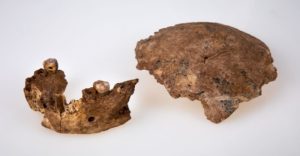 Fossil remains of skull and jaw Tel Aviv University
Fossil remains of skull and jaw Tel Aviv University TEL-AVIV UNIVERSITY and AMERICAN ASSOCIATION FOR THE ADVANCEMENT OF SCIENCE—Nesher Ramla Homo type – a prehistoric human previously unknown to science: Researchers from Tel Aviv University and the Hebrew University of Jerusalem have identified a new type of early human at the Nesher Ramla site, dated to 140,000 to 120,000 years ago. According to the researchers, the morphology of the Nesher Ramla humans shares features with both Neanderthals (especially the teeth and jaws) and archaic Homo (specifically the skull). At the same time, this type of Homo is very unlike modern humans – displaying a completely different skull structure, no chin, and very large teeth. Following the study’s findings, researchers believe that the Nesher Ramla Homo type is the ‘source’ population from which most humans of the Middle Pleistocene developed. In addition, they suggest that this group is the so-called ‘missing’ population that mated with Homo sapiens who arrived in the region around 200,000 years ago – about whom we know from a recent study on fossils found in the Misliya cave.
Two teams of researchers took part in the dramatic discovery, published in the prestigious Science journal: an anthropology team from Tel Aviv University headed by Prof. Israel Hershkovitz, Dr. Hila May and Dr. Rachel Sarig from the Sackler Faculty of Medicine and the Dan David Center for Human Evolution and Biohistory Research and the Shmunis Family Anthropology Institute, situated in the Steinhardt Museum at Tel Aviv University; and an archaeological team headed by Dr. Yossi Zaidner from the Institute of Archaeology at the Hebrew University of Jerusalem.
Timeline: The Nesher Ramla Homo type was an ancestor of both the Neanderthals in Europe and the archaic Homo populations of Asia.
Prof.Israel Hershkovitz: “The discovery of a new type of Homo” is of great scientific importance. It enables us to make new sense of previously found human fossils, add another piece to the puzzle of human evolution, and understand the migrations of humans in the old world. Even though they lived so long ago, in the late middle Pleistocene (474,000-130,000 years ago), the Nesher Ramla people can tell us a fascinating tale, revealing a great deal about their descendants’ evolution and way of life.”
The important human fossil was found by Dr. Zaidner of the Hebrew University during salvage excavations at the Nesher Ramla prehistoric site, in the mining area of the Nesher cement plant (owned by Len Blavatnik) near the city of Ramla. Digging down about 8 meters, the excavators found large quantities of animal bones, including horses, fallow deer and aurochs, as well as stone tools and human bones. An international team led by the researchers from Tel Aviv and Jerusalem identified the morphology of the bones as belonging to a new type of Homo, previously unknown to science. This is the first type of Homo to be defined in Israel, and according to common practice, it was named after the site where it was discovered – the Nesher Ramla Homo type.
Dr. Yossi Zaidner: “This is an extraordinary discovery. We had never imagined that alongside Homo sapiens, archaic Homo roamed the area so late in human history. The archaeological finds associated with human fossils show that “Nesher Ramla Homo” possessed advanced stone-tool production technologies and most likely interacted with the local Homo sapiens“. The culture, way of life, and behavior of the Nesher Ramla Homo are discussed in a companion paper also published in Science journal today.
Prof. Hershkovitz adds that the discovery of the Nesher Ramla Homo type challenges the prevailing hypothesis that the Neanderthals originated in Europe. “Before these new findings,” he says, “most researchers believed the Neanderthals to be a ‘European story’, in which small groups of Neanderthals were forced to migrate southwards to escape the spreading glaciers, with some arriving in the Land of Israel about 70,000 years ago. The Nesher Ramla fossils make us question this theory, suggesting that the ancestors of European Neanderthals lived in the Levant as early as 400,000 years ago, repeatedly migrating westward to Europe and eastward to Asia. In fact, our findings imply that the famous Neanderthals of Western Europe are only the remnants of a much larger population that lived here in the Levant – and not the other way around.”
According to Dr. Hila May, despite the absence of DNA in these fossils, the findings from Nesher Ramla offer a solution to a great mystery in the evolution of Homo: How did genes of Homo sapiens penetrate the Neanderthal population that presumably lived in Europe long before the arrival of Homo sapiens? Geneticists who studied the DNA of European Neanderthals have previously suggested the existence of a Neanderthal-like population which they called the ‘missing population’ or the ‘X population’ that had mated with Homo sapiens more than 200,000 years ago. In the anthropological paper now published in Science, the researchers suggest that the Nesher Ramla Homo type might represent this population, heretofore missing from the record of human fossils. Moreover, the researchers propose that the humans from Nesher Ramla are not the only ones of their kind discovered in the region, and that some human fossils found previously in Israel, which have baffled anthropologists for years – like the fossils from the Tabun cave (160,000 years ago), Zuttiyeh cave (250,000), and Qesem cave (400,000) – belong to the same new human group now called the Nesher Ramla Homo type.
“People think in paradigms,” says Dr. Rachel Sarig. “That’s why efforts have been made to ascribe these fossils to known human groups like Homo sapiens, Homo erectus, Homo heidelbergensis or the Neanderthals. But now we say: No. This is a group in itself, with distinct features and characteristics. At a later stage small groups of the Nesher Ramla Homo type migrated to Europe – where they evolved into the ‘classic’ Neanderthals that we are familiar with, and also to Asia, where they became archaic populations with Neanderthal-like features. As a crossroads between Africa, Europe and Asia, the Land of Israel served as a melting pot where different human populations mixed with one another, to later spread throughout the Old World. The discovery from the Nesher Ramla site writes a new and fascinating chapter in the story of humankind.”
The findings indicate that this archaic lineage may represent one of the last surviving populations of Middle Pleistocene Homo in southwest Asia, Africa and Europe. In a companion study, Zaidner et al. provide the archaeological context of the new fossils, reporting on the associated radiometric ages, artifact assemblages and the behavioral and environmental insights they offer. Zaidner et al. show that the Nesher Ramla Homo were well versed in technologies that were previously only known among H. sapiens and Neanderthals. Together, the findings provide archaeological support for close cultural interactions and genetic admixture between different human lineages before 120,000 years ago. This may help explain the variable expression of the dental and skeletal features of later Levantine fossils. “The interpretation of the Nesher Ramla fossils and stone tools will meet with different reactions among paleoanthropologists. Notwithstanding, the age of the Nesher Ramla material, the mismatched morphological and archaeological affinities, and the location of the site at the crossroads of Africa and Eurasia make this a major discovery,” writes Marta Lahr in an accompanying Perspective.
Prof. Gerhard Weber, an associate from Vienna University, argues that the story of Neanderthal evolution will be told differently after this discovery: “Europe was not the exclusive refugium of Neanderthals from where they occasionally diffused into West Asia. We think that there was much more lateral exchange in Eurasia, and that the Levant is geographically a crucial starting point, or at a least bridgehead, for this process.”
______________________________
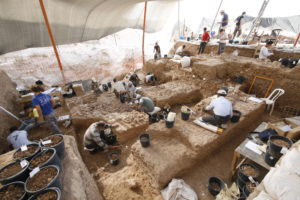
Field excavation at Nesher Ramla. View of the excavation. Yossi Zaidner
______________________________
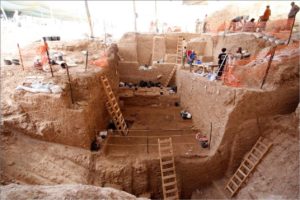
View of the deep section during excavation at Nesher Ramla. Photograph showing the deep
archaeological sequence. Yossi Zaidner
______________________________

Fossil remains of skull and jaw Tel Aviv University
______________________________
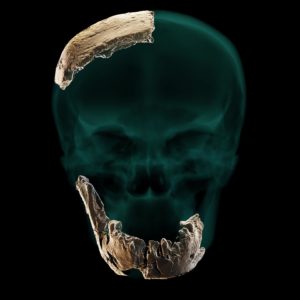
Static skull & mandible & parietal orthographic. Tel Aviv University
______________________________
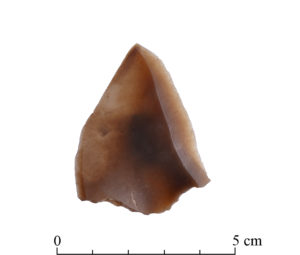
A stone tool of the Nesher Ramla Homo – Levallois point. Tal Rogovski
______________________________
Research Summary of Findings and Conclusions:
- The discovery of a new Homo group in this region, which resembles Pre-Neanderthal populations in Europe, challenges the prevailing hypothesis that Neanderthals originated from Europe, suggesting that at least some of the Neanderthals’ ancestors actually came from the Levant.
- The new finding suggests that two types of Homo groups lived side by side in the Levant for more than 100,000 years (200-100,000 years ago), sharing knowledge and tool technologies: the Nesher Ramla people who lived in the region from around 400,000 years ago, and the Homo sapiens who arrived later, some 200,000 years ago.
- The new discovery also gives clues about a mystery in human evolution: How did genes of Homo sapiens penetrate the Neanderthal population that had presumably lived in Europe long before the arrival of Homo sapiens?
- The researchers claim that at least some of the later Homo fossils found previously in Israel, like those unearthed in the Skhul and Qafzeh caves, do not belong to archaic (early) Homo sapiens, but rather to groups of mixed Homo sapiens and Nesher Ramla lineage.
Article Source: TEL-AVIV UNIVERSITY and AMERICAN ASSOCIATION FOR THE ADVANCEMENT OF SCIENCE news releases.
Advertisement



